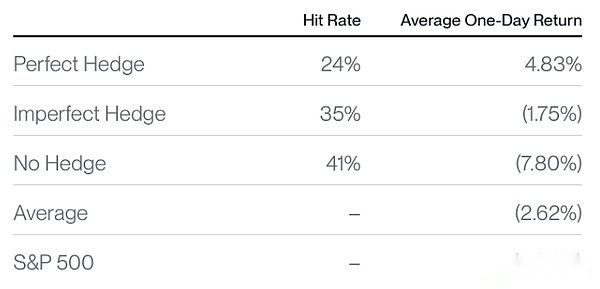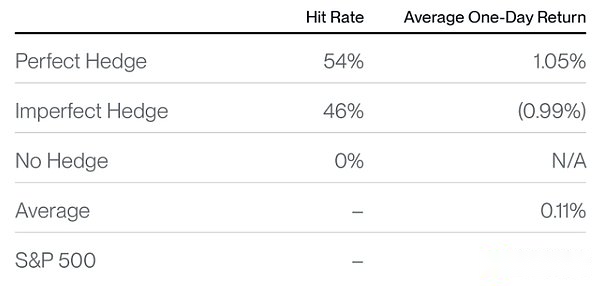
Author: Juan Leon, senior investment strategist at Bitwise; compiled by: 0xjs@Bitlink Vision
On August 5, global stock markets fell into panic, with the Japanese Nikkei falling 12%, the largest single-day drop since 1987, and the S&P 500 closed down 3%.
Unfortunately, Bitcoin’s performance wasn’t much better, plunging 14.52% between August 2 and August 5.The sharp callback has triggered a lot of questions from the media: Why did Bitcoin fail as a hedging tool?Is Bitcoin really a hedging asset?
Out of curiosity, I decided to delve into the historical data.
Specifically, I analyzed the S&P 500’s decline by 2% or more per day over the past decade and observed how Bitcoin and gold react.
I then divided their returns into three categories based on the performance of each asset on the day the S&P 500 fell:
-
Perfect hedging——This asset provides positive returns
-
Partial hedging——The asset produces negative returns but outperforms the S&P 500 index
-
No hedging—The asset’s return is worse than the S&P 500 index
What I found was more inspiring and subtle than what I usually reported.
Is Bitcoin a short-term hedging tool?Not so.
First, let’s talk about the bad news about Bitcoin:Data shows that Bitcoin is an unreliable short-term hedging tool.In fact, its single-day rate of return seems to have nothing to do with stock market trends.
For more than half of the time (59% to be exact), it acted as a hedge, and on days when the S&P 500 was down, it either rose sharply or fell less than stocks.But for the other 41% of the time, it fell more than the index.
Unfortunately, when this happens, things tend to get bad: when the stock falls 2% or more and Bitcoin is underperforming, it really goes down, with an average drop of 7.80%.
This tells me that not all single-day callbacks are the same.Of course, the reasons why stocks fall 2% on a certain day vary.The data show thatSome of these causes a sharp rise in Bitcoin, while others cause a sharp decline in Bitcoin; there are no hard regulations.
If you are looking for a foolproof one-day hedging method to fight a sharp pullback in the stock market, Bitcoin is not a good choice.
Bitcoin

Source: Bitwise Asset Management, data from Bloomberg.The data range is from January 1, 2014 to August 9, 2024.
gold

Source: Bitwise Asset Management, data from Bloomberg.The data range is from January 1, 2014 to August 9, 2024.
Gold performed better, despite mixed performance: Gold achieved positive returns during the 54% time the S&P 500 fell sharply, but on average, gold rose only 1.05% during this period.This makes gold a powerful short-term hedging tool challenging: you have to hold a lot of gold to have a real impact on your overall portfolio.If 5% of your portfolio is gold, then this 1% change has little effect on alleviating the pullback of traditional 60% stock allocation in your portfolio.Gold fell by an average of 0.99% over the remaining 46% of the time, resulting in a loss in portfolios.
Fortunately, most of us invest not overnight, but long-term investment.So, I wonder how these two assets perform as long-term tools to hedge against these one-day shocks?
Historically, is Bitcoin a long-term hedging tool?Absolutely.
The track record of the two assets throughout the year tells a completely different story.A year after the stock market pullback of 2% or more, gold returns at 7.88%, well behind the stock market rebound.However, Bitcoin’s average return rate is as high as 189.68%, which is enough to make up for its volatility.
Average return rate for the year after the S&P 500’s sharp decline

Source: Bitwise Asset Management, data from Bloomberg.The data range is from January 1, 2014 to August 9, 2024.
This dynamic makes sense.Gold is a trustworthy asset that many people instinctively buy gold during short-term panic.But its maturity means it does not perform well over a longer period of time.Bitcoin has limited supply and reduced issuance, with strong value preservation characteristics, but is still in the early stages of adoption.Therefore, it still has the factor of risky assets.This means that its single-day response to market pullbacks changes more, but the longer the observation time, the better the return.
The record is clear about the returns over the past decade: when the market falls, buying Bitcoin will pay off.
Will Bitcoin perform well again?
The easiest criticism of this analysis is that past performance does not guarantee future performance.While this time may be different, Bitcoin’s 12-month outlook is one of the most optimistic outlooks I’ve seen.
Consider the following potential catalysts:
1. Spot Bitcoin ETP inflow:Bitcoin ETP inflows have exceeded $17 billion since January, pushing Bitcoin to hit an all-time high earlier this year.These inflows do not even include some of the largest players.Last week, Morgan Stanley became the first major securities company to approve the launch of Bitcoin ETP on its platform.We expect Merrill Lynch, UBS, Wells Fargo and others to follow suit.
2. Supervisory trend:A bipartisan coalition of Congress has pushed the House to pass three cryptocurrency bills this year.The industry is about to usher in a regulatory brightening as the Republicans incorporate cryptocurrencies into its official 2024 platform and the Harris campaign reassess its stance.
3. Fed cuts interest rates:Central banks such as the European Central Bank and the Bank of England have begun to cut interest rates.The Fed must catch up with concerns about recession as U.S. inflation slows down and weak economic data triggers.Federal Funds Futures already expects the Fed to cut interest rates at its September meeting.
Have we gotten out of the predicament?Probably not yet.Investors are still upset about the market volatility caused by closing positions in the yen arbitrage trading.Coupled with uncertainty in the U.S. presidential election, signs of a global economic slowdown, and the imminent threat of conflict between Iran and Israel, more turmoil will occur in the future.But the next time the stock market sells, you will know which asset is the best long-term hedging tool.








